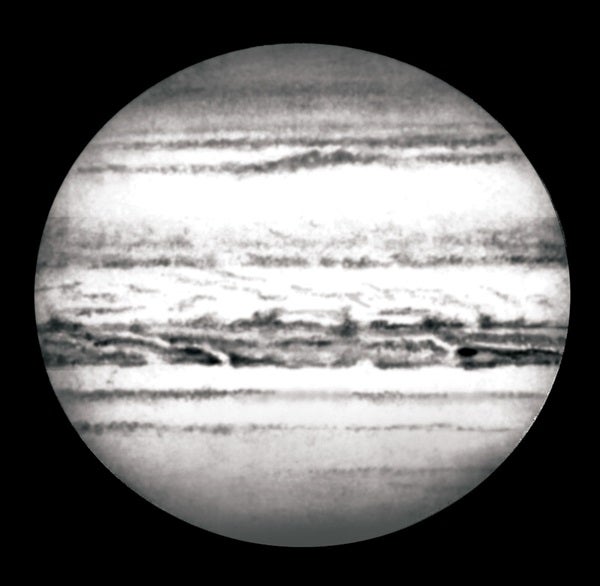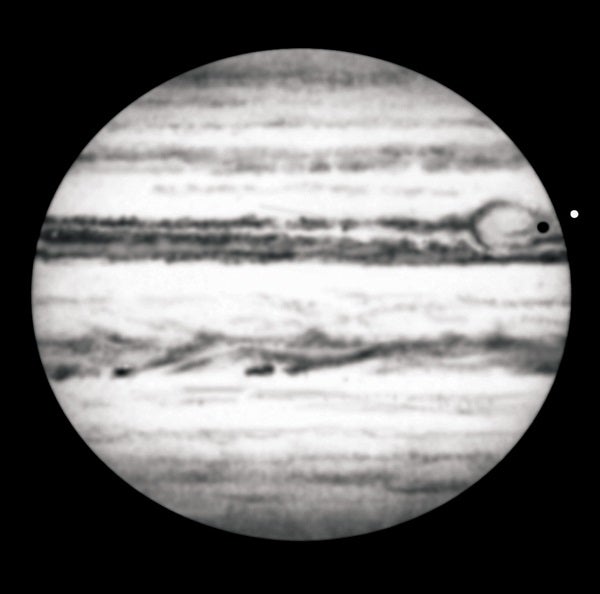If you’ve ever sketched a solar prominence or tackled the lunar terminator, you’ve gotten a taste of drawing fast-moving scenes with little time to spare. Jupiter falls into this category.
With a rotation rate of nine hours and 55 minutes, the giant planet’s features appear quickly and disappear just as fast. This month, Jupiter makes a great target because it reached opposition (when it lay across the sky from the Sun as seen from Earth) January 5. That means this month, it rises before sunset and is high in the sky during the more convenient evening hours.
You’ll have no trouble finding Jupiter after evening twilight fades, shining brighter than anything else in the southern sky. Currently, it lies in the constellation Gemini the Twins. For best results, sketch it when it lies due south because that’s when the gas giant will be at its highest and you’ll be looking through the least amount of our atmosphere. Air turbulence washes out detail, so strive for a night when you get an undistorted view using a magnification of 25x to 35x for each inch of your telescope’s aperture.
A fascinating feature to observe in Jupiter is its weather patterns. Its atmosphere is mainly hydrogen, helium, and other compounds that, when condensed, form bands across the planet’s disk. Color filters can enhance these features, so make sure to try a few during your observation.
Through the smallest telescopes, you’ll see the Galilean moons — Io, Europa, Ganymede, and Callisto — easily, plus you’ll pick up hints of Jupiter’s equatorial belts. Although you can see the giant storm known as the Great Red Spot through a 3-inch telescope, colors and features within the belts become more defined using larger scopes. Something else a telescope will reveal is that the planet’s rapid rotation pushes material toward the equator, creating an elliptical shape. A Jupiter-observing template illustrating this can be found on the Association of Lunar and Planetary Observers website at http://alpo-astronomy.org.
As you observe, record the time and draw the boundaries of the major belts you see. Next, add prominent features you can use as reference points, then fill in the remainder of the sketch. Start with the preceding limb (the edge of the planet where features are disappearing) to catch details before they rotate out of view. Be prepared to render subtle tones when they emerge during moments of the sharpest seeing.
Try varying your sketches. You’re not limited to drawing the entire disk. For example, you can create strip sketches by focusing solely on the equatorial belts or by mapping Jupiter during a period of several hours. Planetary observer Paul Abel recorded more than half the planet over six hours by creating a strip map, which you can see on the Astronomy Sketch of the Day website at www.asod.info/?p=9636.
Your sketch kit should include assorted graphite pencils graded for hardness and blackness. For example, a 4H pencil has hard lead that produces faint strokes, whereas a 4B pencil will let you create dark black markings. An HB falls in the middle of the pencil range. Using an eraser shield (a metal or plastic plate with different sizes and shapes of openings) gives you more control as you draw belts or satellite transits.
Remember, sketching skills improve with each observation, so keep at it. You’ll soon become a master at sketching the jovian atmosphere.












